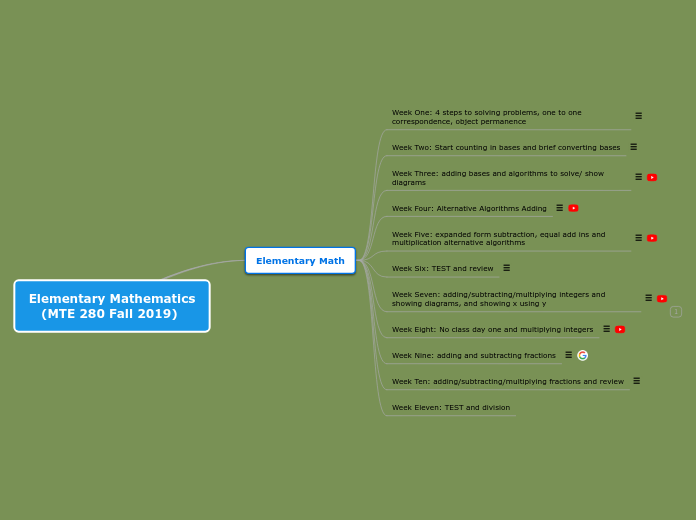przez Emily Sherman 6 lat temu
359
Elementary Mathematics (MTE 280 Fall 2019)

przez Emily Sherman 6 lat temu
359

Więcej takich
adding fractions uses 3 rectangles
subtracting fractions uses two rectangles
multiplying fractions takes one rectangle
what does the numerator and denominator mean?
Numerator: number of pieces we have
Denominator: how big a piece is going to be
anchor fraction: fraction we know that helps us figure out other fractions
*never put a fraction over 1*
if the first number is negative then you need a zero bank
rules:
1) if the signs are the same: +
2) if the signs are different: -
2(-3): two groups of 3 negatives
-3(-1): take away 3 groups of 1 negative
always need ENOUGH two sided counters when trying to add pairs to make a certain number
a zero pair is when a positive and a negative cancel each other out
a zero bank is when you have multiple zero pairs (as many as needed)
show -5 using 9: ++-------
74(++) + -38(-)= 36
going to have to figure out how to add a document because I was trying to upload my review pages as a reference and it was not letting me do so
Lattice multiplication (video)
Equal add ins: Adding the same thing to both numbers to make it easier to subtract
27-14 (add 3 to both) 30-17= 13
55-38 (add 2) 57-40= 17
expanded:
48-15= 40+8 - 10+5= 33
friendly numbers:
37+28= 35+30= 65
Array: separated sporadic
Area Model (video)
Left to right:
358+296= 500+140+14= 654
Trading off:
8+5= 10+3= 13
7+9= 6+10= 16
Scratch:
count in the bases and when you reach the number that your base is, put a slash through the number. then you'll continue adding and count up all the slashes (hard to explain and it make sense since I know what I'm doing so I have to figure out how to add pictures because it won't let me)
Convert to base 10:
43 seven --> llll... = 31
Solving base 10 conversions:
4312six --> 4(6^3)+3(6^2)+1(6^1)+2(6^0)
LLLLLeaving base 10:
stranger things division
8 l__37___ = 45eight
4 l 5
l
14 nine --> ............. = 13
23 seven --> ................. = 17
16 eight --> .............. = 14
When no base is written, it is considered to be base 10
Convert 23 to base seven --> lll.. = 32seven
convert 43 to base 5 --> ◼️lll... = 133five
🔳 = cube
◼️ = flat
l = long
. = unit
Four steps to solving problems:
One to one correspondence: know how to count and then classifying an object as one
Object permanence: knowing how many objects are there without having to recount